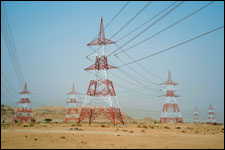 — S.N. Sunkari, Joint General Manager – Business Development (Power Transmission), L&T Infrastructure Development Projects Ltd
— S.N. Sunkari, Joint General Manager – Business Development (Power Transmission), L&T Infrastructure Development Projects Ltd
In around August 2013, Larsen & Toubro Group debuted in power transmission development when group company L&T Infrastructure Development Projects Ltd clinched the Kudgi power transmission project under the tariff-based competitive bidding mechanism. We have S.N. Sunkari, in this exchange, telling us how for L&T Group with tremendous EPC contracting experience in power transmission infrastructure, becoming a transmission service provider was a logical extension. An interview by Venugopal Pillai.
We appreciate that the Kudgi transmission project marks L&T Group’s debut as a developer of power transmission infrastructure.
Kudgi project gave us a fillip start into the transmission business vertical after a long wait. Though there were ample opportunities both in the central as well state sector, we were cautious and chose to wait and watch for our turn.
With vast experience in the EPC space, the transmission business vertical has always been a preferred area for L&T Group to enter into as an investor and developer.
Tell us more on the rationale of entering the power transmission development space, and the scope that you see going forward.
The following points supplement the rationale behind entering into transmission development space:
(i) As per the 12th Five-Year Plan projections on power transmission, ample business opportunity is available in both central and state sector. L&T IDPL believes that the transmission vertical is a potential business area and no single entity can meet such a large requirement to bridge between generation and distribution system across country.
(ii) Though there are implementation challenges during construction phase, once implemented the revenue model is fixed in nature and is immune from economic growth and industrialization etc.
(iii) With fast changing global economic scenarios, L&T IDPL prefers to invest in such fixed revenue models. We are targeting to achieve Rs.10,000-crore power transmission business portfolio size in next five years.
Please describe the scope of the Kudgi transmission project. What would be the project cost and how is it going to be financed?
The scope of the Kudgi project includes following transmission lines:
- 2 Nos. x 400kV double circuit (Quad Moose) line from Kudgi TPS switchyard to Narendra (New)
- 765kV double circuit (Hexa Zebra) line from Narendra (New) to Madhugiri
- 400kV double circuit (Quad Moose) line from Madhugiri to Bidadi
The approximate project cost is Rs.1,300-plus crore. The project, to be financed through a consortium of banks and financial institutions, has already achieved financial closure in February 2014.
What is the broad current status of the project and when do you expect physical work to begin?
We have obtained regulatory clearances such as Transmission License and Tariff adoption from Central Electricity Regulatory Commission in time. Approval u/s 164 is in process.
As far the physical progress is concerned, being a fast track project we have commenced foundation activity in January 2014 and tower erection is planned from May 2014 onwards.

Larsen & Toubro, as a group, has successfully constructed several challenging power transmission schemes, both in India and abroad. While project execution challenges will always present themselves, what challenges do you now envisage as a developer of transmission lines?
Like every other project Kudgi project has its uniqueness in terms of being one of the longest transmission system (of around 500 km) to be implemented in the shortest time of 28 months from effective date.
Unlike EPC projects, obtaining Right of Use (ROU) is the responsibility of the Transmission Service Provider or developer, in this case L&T IDPL. Being in proximity to industrial and urbanization zones, ROU is going to be a challenge in the Kudgi project. However, L&T as a group has accepted the challenge and will complete the Kudgi project within the scheduled timelines.
Apart from interregional schemes (inter-state) power transmission schemes, is L&T-IDPL equally keen on bidding for intra-state schemes, under the PPP mode?
We are evaluating options and are open for both central and state sector initiated transmission business opportunities, and as a business strategy, participate in selected ones.
The Union power ministry embarked on developing interregional transmission lines on PPP mode using the tariff-based competitive bidding somewhere in 2006-07. How do you rate the overall success so far?
Though the tariff-based competitive bidding model in transmission sector has been in place since 2006 and as many as 10 opportunities have been floated in this route, not many projects have seen the light of day. The success rate is low for the following reasons:
- Lack of awareness of this business model and generic Qualifying Requirements (QR) lead to participation from non-serious players
- Quoting undeliverable bid numbers and unhealthy competition
- Lack of expertise in design & engineering practices
- Theoretical project management practices or age-old techniques used in transmission line construction
- Lack of quality resources across the power transmission sector
- Weak financial health of developers and low economic growth
Having said this, other reasons could be:
- Delays in obtaining regulatory clearances
- Lengthy procedures for obtaining statutory approvals specially forest clearance
- Inadequate project documentation; the RfP and TSA do not address the remedial measures on payment security, cost/time escalations under force majeure conditions to protect developer’s investment
- Financial health of discoms discourages developers from pursuing PPP model projects.
- Due to lack of clarity or uncertainties associated with fuel linkage and power sale policies many generation projects are stranded up which in turn affecting transmission developers.
Given that there is ample scope for private sector enterprise in power transmission development, what would be your suggestions to accelerate private sector participation?
We suggest that government authorities concerned could initiate the following measures, with a view to accelerating private sector participation:
- Clarity on key project documents like RfP, TSA and RSA explaining risks/mitigation mechanism should be brought about. This will protect/comfort private developers’ investments
- Stringent qualifying requirements should be introduced (both technical and financial) to invite participation from serious players
- Accurate timelines shall be defined for granting statutory/regulatory approvals including forest clearance by the government authorities concerned, with deemed approval clause after specified timelines.
- There shall be level-playing mechanism among all transmission developers—both private sector/PSU developers
- Right of Use shall be with Government of India or if it is in developers’ scope, uniform guidelines/compensation mechanism shall be implemented across India through suitable constitutional amendments which are non-challengeable in any court of law.
- Suitable amendments shall be brought in Telegraphic Act 1885 and Indian Forest Act 1927 (amended in 1988) for its effectiveness in handling ROU issues in current scenario.











